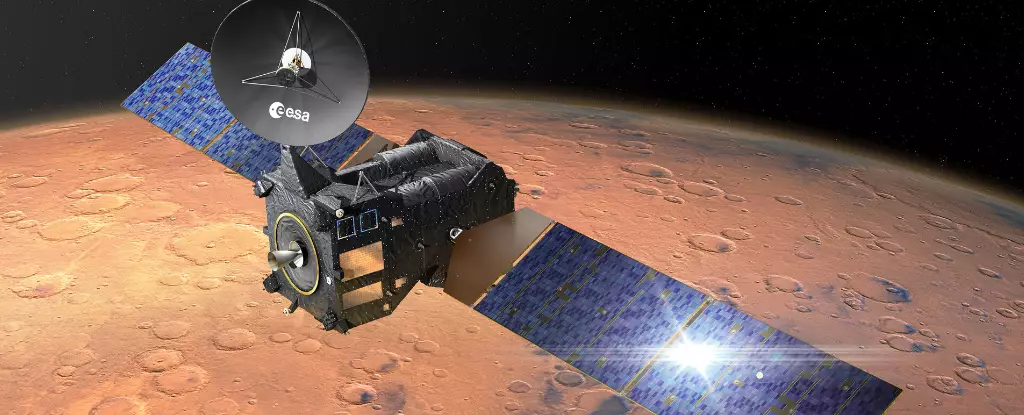In an unprecedented fusion of science, art, and public engagement, the ExoMars Trace Gas Orbiter (TGO) embarked on a groundbreaking endeavor in May 2023 to simulate extraterrestrial communication. Conducted as part of the multidisciplinary art project “A Sign in Space,” this initiative invited citizen scientists across the globe to delve into the rich possibilities of decoding a theoretical message from beyond Earth. This project serves not just as a scientific experiment but as a rich tapestry weaving together culture, creativity, and the enduring question of life beyond our planet.
The inspiration behind “A Sign in Space” can be traced to the imaginative narratives of Italo Calvino, particularly his collection “Cosmicomics,” which creatively explores diverse scientific concepts through storytelling. Spearheaded by Daniela de Paulis, a media artist and licensed radio operator, the project reflects on the nature of communication in the cosmos. Envisioned in collaboration with esteemed partners including the SETI Institute and the European Space Agency (ESA), the artistic endeavor invites participatory science, blurring the traditional lines between expert and layperson in the realm of space exploration.
Once the simulated message was sent from TGO, it was intercepted by multiple radio astronomy observatories on Earth, setting the stage for an intricate puzzle that would engage thousands. In a world where scientific breakthroughs often appear to be the domain of a select few, the idea of utilizing citizen scientists adds a layer of democratization to the scientific process, suggesting that discovery and creativity can thrive in collective contributions from diverse backgrounds.
The response from the global citizen science community was remarkable. Over ten days, more than 5,000 volunteers collaborated online to sift through raw radio signals, employing their skills and ingenuity to extract and decode the message. The urgency of collaboration in this situation points to a crucial evolution within scientific inquiry—one that acknowledges the power of community involvement and fosters a sense of shared purpose.
After tireless efforts and complex simulations, the father-daughter duo of Ken and Keli Chaffin finally unraveled the riddle, revealing a striking image that highlighted five distinct clusters of amino acids. This discovery not only constituted a potential message pertaining to the building blocks of life but also underscored the transformative power of collaboration between different generations. The Chaffins’ method of utilizing a Margolus reversible cellular automaton to decode the message added an innovative computational approach to the challenge, opening new avenues for exploration in mathematical modeling and data representation.
The Implications of Discovering Life’s Building Blocks
The decoded message, presented in a striking retro style, depicted the fundamental elements of life—an interpretation that resonates deeply with both scientific communities and the general public. Ken Chaffin’s meticulous detailing of the decoding process reflects how intricate and sometimes obscure the intersection of art and science can be. His technical explanations, highlighting the role of pixel representations in molecular diagrams, invite deeper understanding and appreciation for the complexities behind what may seem like a simple illustration.
The excitement surrounding the discovery also raises philosophical questions about the nature of communication itself. What does it mean to receive a message from beyond our world? While scientists grapple with the technical nuances of decoding, participants in the project are encouraged not only to reflect on this particular communication but also to explore broader interpretations. Is it an outreach effort, a cultural exchange, or perhaps a call for caution?
Engagement and Future Endeavors: Humanity’s Readiness for Contact
As the project transitions from decoding into interpretation, the role of citizen scientists remains critical. They are encouraged to engage further by discussing their insights on platforms like Discord, ultimately contributing to the ongoing narrative of what this message might represent. The call to action for participants to share their methodologies not only fosters transparency but also encourages a collaborative spirit that thrives on replication and verification.
Ultimately, the question persists: is humanity prepared for the prospect of genuine contact with extraterrestrial civilizations? As participants analyze and theorize about the message, the project illuminates the broader societal implications of such an encounter. The interplay of science and art in this initiative serves as a poignant reminder that humanity’s exploration of the cosmos is as much about understanding ourselves as it is about seeking life beyond Earth. By involving a diverse audience in this dialogue, “A Sign in Space” embodies a forward-thinking approach, enthusiastically tapping into the collective imagination to contemplate our place in the universe.

